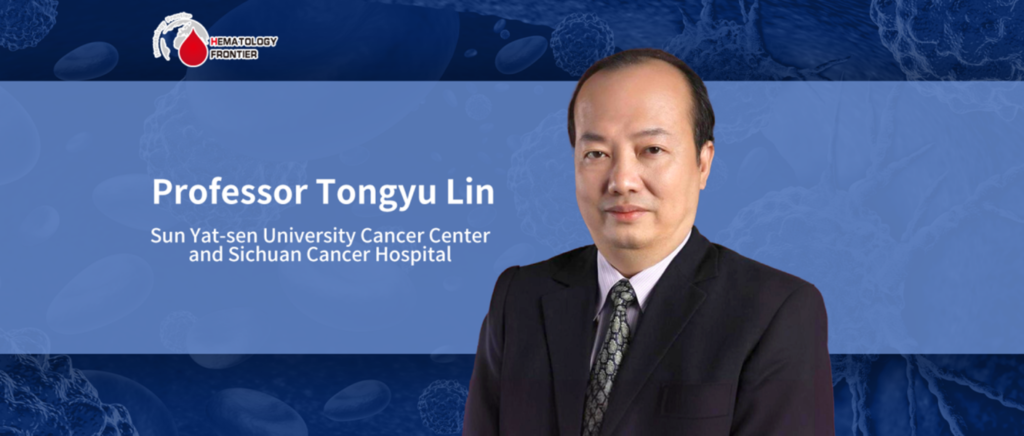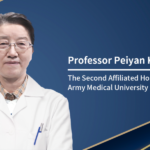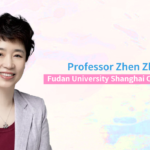
Editor’s Note:To further explore the advances in clinical and pathological diagnosis, treatment, and translational medicine research in lymphoma, the “2024 Nanjing Lymphoma Forum” was held in Nanjing from May 11-12, 2024. At the forum, Professor Tongyu Lin from Sun Yat-sen University Cancer Center and Sichuan Cancer Hospital delivered an academic report titled “Progress in Lymphoma Diagnosis and Treatment – A Comprehensive Overview.” He shared the latest advancements in lymphoma treatment, including immune checkpoint inhibitors, personalized cancer vaccines, immune cell recruiting drugs represented by T cell-engaging bispecific antibodies, and cellular immunotherapy. He emphasized the importance of individualized and precise treatment, multidisciplinary collaboration, and the need for different treatments for different diseases. During the forum, “Oncology Frontier – Hematology Frontier” had the privilege of interviewing Professor Tongyu Lin, who provided an in-depth discussion on breakthroughs in lymphoma diagnosis and treatment, the principles and concepts of precision treatment, and the development of diagnostic and therapeutic teams.
Oncology Frontier – Hematology Frontier: As an authority in the field of lymphoma, you have witnessed the rapid development in lymphoma diagnosis and treatment in recent years. Could you share some of the most groundbreaking advancements in lymphoma treatment and how they have substantially helped patients?
Professor Tongyu Lin: With the advancements in precision diagnosis and treatment, the academic community has come to realize that lymphoma is a group of diseases rather than a single disease. Lymphoma is classified into Hodgkin’s lymphoma and non-Hodgkin’s lymphoma. The 2022 WHO classification update, which expanded NK/T-cell lymphomas from two types to over thirty subtypes, shocked the academic community. The most common subtype, diffuse large B-cell lymphoma (DLBCL), used to be considered one disease but is now divided into 18 subtypes. Understanding these subtypes, their significance, and their treatment differences is crucial.
Firstly, it’s important to recognize that different lymphoma subtypes have different pathological characteristics, primary sites, and treatment directions. For example, primary central nervous system lymphoma (PCNSL) showed efficacy with CD20 monoclonal antibodies in phase II clinical trials, but phase III trials suggested otherwise. Our team discovered that the effectiveness of CD20 monoclonal antibodies depends on whether patients underwent craniotomy. If the blood-brain barrier is disrupted, the antibody can enter the cerebrospinal fluid and be effective. Otherwise, its large molecular size prevents it from crossing the blood-brain barrier. This insight is a major contribution from our team to the treatment of PCNSL.
From this example, we can see the importance of considering the primary site, subtype, stage, and risk stratification of the disease in the era of precision treatment. We aim to cure low-risk patients with simple treatments to avoid excessive toxicity and reduce costs, while high-risk patients require more complex treatments to prolong survival.
Beyond pathology, multidisciplinary collaboration is essential. For instance, the first step in lymphoma diagnosis is a biopsy. Sometimes, clinical judgment strongly suggests lymphoma, but the biopsy doesn’t yield the desired specimen. PET-CT scans show bright lesions, but no pathological confirmation is obtained due to insufficient collaboration across departments. Multidisciplinary discussions beforehand can improve success rates. Similar issues arise in many other cases, where the strengths of different specialties can collectively advance diagnosis and treatment.
Oncology Frontier – Hematology Frontier: With the rise of precision medicine, lymphoma treatment is shifting towards more individualized approaches. How do you think individualized treatment choices should be made based on the specific conditions of lymphoma patients?
Professor Tongyu Lin: Firstly, pathology classification needs to be refined. While B-cell lymphoma classifications are improving, there is still significant progress to be made for T-cell lymphomas, especially NK/T-cell lymphomas. Our team has collaborated with over twenty centers in China to develop the world’s first NK/T-cell lymphoma staging system. Our research results classify NK/T-cell lymphoma into stages I-IV, allowing for stratified treatment:
1. Stage I patients can achieve a 90% cure rate with radiotherapy alone.
2. Stage II patients require concurrent chemoradiotherapy, which can increase the cure rate from 60-70% to 80%.
3. Stage III patients benefit from induction chemotherapy followed by sequential chemoradiotherapy, doubling the overall survival from 30% to 60-70%.
4. Stage IV patients, who have a low survival rate with conventional treatment and are prone to hemophagocytic syndrome, need advanced treatment options like targeted therapies (CD20, CD30, CD38, PD-1) and new methods like cancer vaccines and TCR-T therapy.
Comprehensive knowledge of multiple disciplines is crucial in the era of precision treatment. For example, managing intestinal involvement in tumors requires balancing treatment to reduce symptoms and control the timing of elective surgery versus emergency surgery. Effective multidisciplinary support is vital for improving patient outcomes.
Managing and monitoring immunotherapy is also critical. Immune checkpoint inhibitors (PD-1/PD-L1), cancer vaccines, bispecific antibodies (CD20×CD3, CD19×CD3), and cellular immunotherapy must be used effectively, involving cell-level monitoring. For instance, improving CAR-T therapy outcomes depends on extracting functional, highly active cells at the right stage of treatment. Managing side effects is also essential, as immunotherapy’s efficacy often correlates with toxicity. Proper management can balance efficacy and safety.
In addition to CAR-T, future lymphoma treatment will likely feature CAR-NK, TCR-T, and TIL therapies.
Oncology Frontier – Hematology Frontier: Your team is a leading force in China and globally. What advice do you have for team building and the development of young doctors in the field of lymphoma? How can they seize opportunities, face challenges, and continuously improve their professional skills and clinical practice?
Professor Tongyu Lin: This is a great question. Medicine requires both inheritance and innovation. First, inheritance involves clinical practice accumulation, attending academic conferences, and multidisciplinary rotations. Oncology doctors should rotate through pathology and imaging departments to understand pathological features and markers, enhancing their interpretation of imaging and pathology reports.
Understanding the broader field of oncology, not just a single disease, is also crucial. For example, immune checkpoint inhibitors (PD-1) were first approved for melanoma, causing a sensation in the industry. Their application in lymphoma came much later, so lymphoma doctors must be aware of overall oncology advancements. This comprehensive understanding enables treating different diseases similarly or the same disease differently.
Young doctors should also be innovative. Modern medicine builds on past innovations, requiring young doctors to think critically and learn from various sources.
Teamwork is vital. Internal departmental unity, interdepartmental collaboration, and academic community cooperation are essential for collective learning and progress. Doctors should remain humble in success and resilient in adversity. Constructive criticism from mentors helps prevent future mistakes, emphasizing the importance of diligence, compassion, patience, ambition, and perseverance.
Oncology Frontier – Hematology Frontier: The field of lymphoma has seen rapid drug development and the emergence of new therapies. What breakthroughs can we expect from domestically developed new drugs or therapies in addressing the challenges of lymphoma diagnosis and treatment?
Professor Tongyu Lin: The lymphoma field has indeed progressed rapidly. ADC drugs are increasing in number, and antibody-based therapies are expanding in targets, such as CD20 and CD19. Bispecific antibodies (CD20×CD3, CD19×CD3) and small molecule inhibitors (BTK, mTOR, BCL-2, HDAC) are advancing. The domestic EZH1 inhibitor gained global attention at last year’s ASH conference.
With the abundance of new drugs, choosing the right treatment and ensuring precision diagnosis are crucial. For example, the combination of R-CHOP and other drugs (e.g., Polatuzumab, targeting CD79b) should consider prior target detection to ensure efficacy. Establishing detection standards for targets like CD79b is essential, and our hospital welcomes national collaboration in this area.
Cost is another important factor. Expensive therapies (e.g., CD20×CD3 bispecific antibodies + R-CHOP) should be optimized for the right patients to maximize benefits.
Small molecule drugs, such as BCL-2 inhibitors, BTK inhibitors, and proteasome inhibitors, offer diverse treatment options. Combining these with other therapies can significantly benefit patients, requiring extensive research.
Future breakthroughs in lymphoma will focus on stratified and precision treatment. Each drug must be matched to the right patient population based on risk stratification and molecular characteristics. Precision treatment is akin to tailoring clothes, considering individual differences to find the most suitable options. This requires continuous academic effort and exploration. On the occasion of Mother’s Day and Nurses’ Day, I hope our work brings happiness and hope to more families. Happy holidays to all mothers and nurses!

Professor Tongyu Lin
– Chief Physician, Doctoral Supervisor, and Chief Expert
– President of Sichuan Cancer Hospital
– Sun Yat-sen University Cancer Center
– Positions:
– Chairperson of the Oncology Branch of the Chinese Medical Association
– Leader of the Lymphoma Group of the Oncology Branch of the Chinese Medical Association
– Chairperson of the Lymphoma Quality Control Committee of the National Cancer Quality Control Center
– Chairperson of the Rare Tumor Expert Committee of the Chinese Society of Clinical Oncology (CSCO)
– Chairperson-elect of the Melanoma Expert Committee of CSCO
– Vice President of the China Lymphoma Alliance of CSCO
– Deputy Chairperson of the Chinese Anti-Cancer Drug Safety Management Expert Committee
– President of the Chinese Southwest Oncology Group (CSWOG)
– Reviewer for the National Natural Science Foundation, National Rational Drug Use Expert Committee, and National Medical Accident Expert Committee
– Vice President of the Sichuan Medical Association
– Honorary Chairperson of the Oncology Branch of the Guangdong Medical Association


